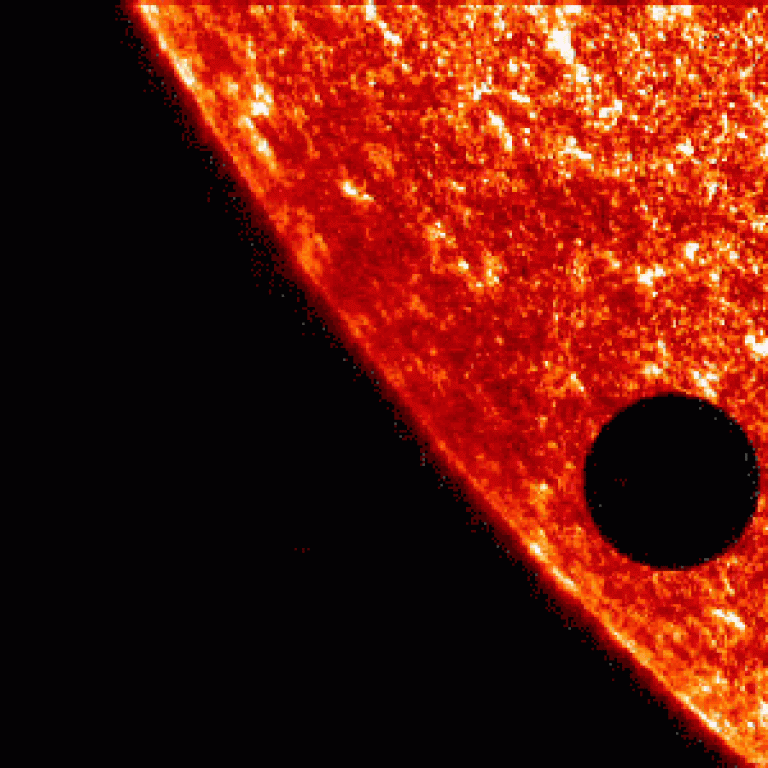Venus transit pays homage to physics' past and future
1 June 2012
On June 5 and 6 2012, as Venus passes in front of the Sun, the world will witness a spectacle of the Solar System that will not be seen again until 2117.
 While studies of Venus stretch back to ancient times, the transit of Venus continues to be of relevance to our on-going scientific exploration of the planets in our Solar System and beyond, with several teams at UCL playing a significant role in its observation.
While studies of Venus stretch back to ancient times, the transit of Venus continues to be of relevance to our on-going scientific exploration of the planets in our Solar System and beyond, with several teams at UCL playing a significant role in its observation.
Launched six years ago, the Hinode spacecraft - a Japanese solar physics mission - will be using its three telescopes to study the transit. Besides housing the telescopes, Hinode also contains a special bit of UCL-designed equipment that will be making important measurements on those particular days.
"As the light from the Sun passes through the atmosphere of Venus, signatures of the composition of the planet's atmosphere are imprinted in the sunlight," says Dr Lucie Green (UCL Mullard Space Science Laboratory) who studies the data from Hinode. "Studying Venus in this way enables scientists to test methods of measuring the atmospheres of planets around other stars."
Winds of change
Developed at UCL Mullard Space Science Laboratory, the EUV spectrometer will be studying the interaction between the wind of charged particles that constantly streams away from the Sun and impinges of Venus' thick atmosphere.
History is being made here... This is the first time ever a spacecraft has been in Venus orbit during a transit.
Professor Andrew Coates
The transit of Venus is also being studied in situ by the European Venus Express mission and the Exoplanet Characterisation Observatory (ECHO) mission, which is searching for signs of life in the universe.
"History is being made here," says Professor Andrew Coates (UCL Mullard Space Science Laboratory), a co-investigator on the Venus Express mission. "This is the first time ever a spacecraft has been in Venus orbit during a transit."
With no magnetic field, sulphuric acid cloud, and a thick, carbon dioxide-rich atmosphere, Venus express will take measurements of its namesake's hellish atmosphere.
"These measurements can be compared with earthbound telescope measurements made at the same time. It's a unique chance to test techniques for extrasolar planetary atmosphere studies from future spacecraft - and impossible to repeat until 2117," says Professor Coates.
Historical significance
When Venus passes across the sun on those days in early June, although it will be seen only as a small, black disc, 1/32th the width of the Sun, the transit represents the most important event in the history of the Solar System. As it is this tiny disk that helped astronomers calculate the distances to the planets at a time when several parts of the globe were still poorly known.
It was the German astronomer and mathematician Johannes Kelper that started the process in the 1600s with his three laws of planetary motion. Published in 1619, it was Kepler's third law that gave the relative distances of the planets from Sun, but not their exact distances in kilometres.
In a stroke of genius in 1716, Edmond Halley announced that a simple method known as parallax could be applied to observations of the transit to allow the distance between the Sun and the Earth and therefore all the planets, to be determined.
"Parallax is the shift that you see in an object, against a background, when viewed from different locations," says Dr Green. "Like holding up your thumb and looking at it first only through your left eye, then through only your right."
Although Halley died in 1742, his plea to astronomers to make observations of the transit from widely separated locations on the Earth wasn't forgotten and the transits of 1761 and 1769 were observed. The latter included Cook's voyage to Tahiti.
Gaining the exact timings of Venus' passage across the Sun was crucial to obtain an accurate Sun-Earth distance, however a surprising effect was seen through the telescopes that hampered the observations.
"When Venus was inside the Sun's disk, and close to the edge, a black 'drop' appeared that elongated the disc of Venus and made timing its passage extremely difficult," says Dr Green.
It is this effect that Hinode will seek to avoid, as together the telescopes will study the science behind the black drop effect that blighted so many of the observations in the 1700 and 1800's.
Besides Hinode, UCL is also leading a proposal to the European Space Agency for a mission called ECHO, which will use the transits of planets around distance stars to characterise the atmospheres of these planets and help understand their suitability for life. Therefore several centuries on, Venus still plays an integral part in our understanding of the solar system, and may play a key role in its future too.
Image 1: Images from the TRACE satellite of the Venus transit in 2004
Image 2: Global radar view of the surface from Magellan radar imaging between 1990-1994 (Credit: NASA)
Links:
UCL Mullard Space Science Laboratory
Hinode
Venus Express
ECHO
 Close
Close

